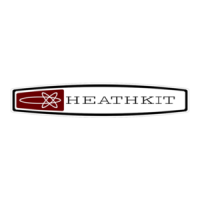Page 2
cm-a
INTRODUCTION
The Heathkit Model HD-10 Electronic Keyer uses
solid-state (transistor) circuitry to provide
clean, "bounce-free" keying. It will produce
self-completing dots and dashes at speeds ad-
justable from
15
to over 60 words per minute.
(Alternate connections provide a speed range of
10 to 20 words per minute.)
Transmitters that use grid-block keying, or
other types of keying where a negative (bias)
voltage
is
shorted to ground to key the trans-
mitter, can be used with the Electronic Keyer.
A built-in audio generator and speaker allows
you to monitor the keying of the transmitter.
Also a speaker-muting headphone jack is pro-
vided in case you prefer to use headphones for
monitoring. When using headphones you can
also listen to the received signal without exter-
nal switching. Screw terminals are provided on
the rear of the Electronic Keyer for connecting
to the headphone output of the receiver.
Keying is accomplished with a keying lever and
two small snap-action switches, one for dots and
the other for dashes. For dots, the keying lever
is moved to the right; for dashes, the keying
lever
is
moved to the left. This keyingsequence
can be reversed by simply reversing the con-
nections to the snap-action switches.
The Hold position of the slide switch can be used
to continuously key the transmitter for tuning or
other adjustments. Also, you can connect a
straight or speed key to the Electronic Keyer
for conventional nonautomatic keying.
b
Normally, the Electronic Keyer
is
operated
from a standard 105 to 125 volt AC line.
How-
4
ever, there are provisions for battery opera-
tion for emergency service. Operation from a
230 volt 50 or 60 cps AC line
is
also possible
by adding a suitable capacitor (not supplied)
in
series with one side of the AC line. Informa-
tion on battery and 230 volt operation is in-
cluded in the Installation section of the Manual.
The Electronic Keyer will prove to be a valuable
and most versatile addition to your other ama-
teur radio equipment. When youbecomefamiliar
with its use, you will undoubtedly improve the
clarity of your
CW
transmissions and the con-
venience of operating.
complete information on unpacking, tools, wiring,
soldering, and step-by-step assembly proce-
dures.

